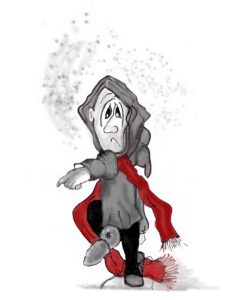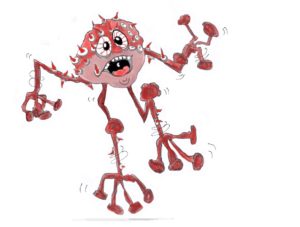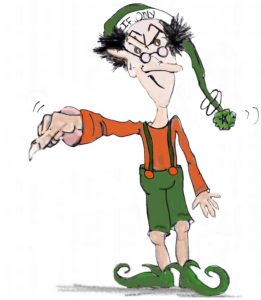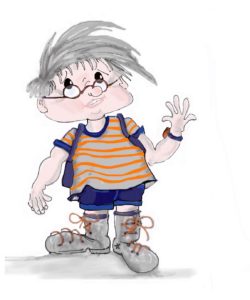© Growing Great Schools™ Worldwide, 2017-19
Meet the characters: find out about the stories: learn about the toolkits
You know how sometimes there’s a little voice in your head that says things like ‘that’s not fair’ or ‘that stupid idiot missing the goal’ or ‘I wonder if Mel still wants to be friends with me’. Most of the time these voices are just thoughts but sometimes they are attached to some strong feelings such as excitement, anger, disgust, fear or misery.
We make sense of the world by how we think about things. Some ways of thinking are helpful – but others are not. They can make tricky situations worse and make us feel bad.
These six wellbeing stories are about alternative ways of thinking. There are ten characters to represent different kinds of self-talk. These are either helpful to you or really not helpful at all and get in the way of your wellbeing big time!
The positive characters give you good ideas and good feelings but the negative ones usually make you feel horrible. They sometimes encourage you to think nasty things about other people. Recognising these different voices shows there are choices about how you see the world and how you deal with what happens to you. Making friends with the positive characters will help you bounce back when things are tough.
It is hard to do this all by yourself so in each story someone else lends a hand.
You can download this Introduction to all of the characters here:-
- A4 version:
Introduction to the Wellbeing Stories A4 - A4 version with a sample chapter from Irfan and the If-Only Elf, and the relevant pages from the Irfan Teacher Toolkit:
Introduction to the Wellbeing Stories with sample chapter-A4 - Booklet version – folds to A5 booklet when printed double-sided on A4 paper (short-edge binding):
Introduction to the Wellbeing Stories A5 booklet
You can watch Sue Roffey reading one of the stories to an online audience here:
Information for Teachers and Families
These six Wellbeing Stories address issues facing young people that may impact on their mental health. These include:
- test anxiety
- transition to high school and the challenge of change
- loss and depression
- perfectionism
- organisation issues
- entitlement and negativity
The main theme incorporates characters representing positive and negative thinking and the difference these make on how you see yourself, other people and the situations you face. There are, however, other strands that link to resilience, such as the power of positive relationships and supportive peers and adults. The psychologies underpinning the stories are positive, narrative, and cognitive behavioural. Every suggestion has an evidence base.
The stories are written for 8-11 year olds but are not intended to be stand-alone narratives.
The Toolkits
Each story, divided into ten short chapters, is accompanied by a teacher toolkit and a family toolkit.
Each Teacher Toolkit gives one or two whole class activities for each of the ten chapters. These are all based in the Circle Solutions pedagogy for social and emotional learning and the ASPIRE framework that underpins this. ASPIRE stands for Agency, Safety, Positivity, Inclusion, Respect and Equity. How this works in practice is explained at the beginning of each Teacher Toolkit. There are also photocopiable resources for many of the activities. As some activities are more advanced than others, you will need to choose those that are most suitable for the age of your students and their level of understanding. [Also see the How to get the most out of the educational package page on this site]
The Family Toolkits go into more depth about the issue the story is addressing and suggest ways families can help. Each toolkit also covers suggestions about how to talk with children about the story. There are links to resources, including on-line organisations, further reading and video clips.
How to get the stories
Printed copies of the stories are available either in complete sets or as individual stories.
An EDUCATION full set consists of one copy of this Introduction, the 6 Stories, the 6 Teacher Toolkits and 6 Family Toolkits, and a pack of photocopiable resources.
A FAMILY full set consists of one copy of this Introduction, the 6 Stories, and 6 Family Toolkits.
Each individual story is also available as a Family set – Story plus Family Toolkit, a Teacher set – Story plus Teacher Toolkit, or as an Education set – Story with both Toolkits.
Click here to buy individual stories.
Schools who need multiple copies of the stories can purchase an electronic copy of the complete set together with a licence to print the stories for their own use. Click here for more details. Contact admin@ growinggreatschoolsworldwide.com if you’re interested.
NB: The ‘Offer’ prices shown in the store are Introductory Offer prices that will apply through to the end of July 2019. The stories have not previously been available at the higher price.
Meet the Characters
First are the nasty NEGATIVE VOICES. You will probably recognise some of these.
 SoBS is the Sprite of Bad Stories. She is a nasty two-faced creature that sees the worst in everyone and the worst in everything. She can pretend to be your friend but all she is interested in is nasty gossip, putting people down and horror stories. SoBS is there whenever any bullying or blaming is going on. It is easy to believe what SoBS is saying – things like:
SoBS is the Sprite of Bad Stories. She is a nasty two-faced creature that sees the worst in everyone and the worst in everything. She can pretend to be your friend but all she is interested in is nasty gossip, putting people down and horror stories. SoBS is there whenever any bullying or blaming is going on. It is easy to believe what SoBS is saying – things like:
‘Don’t talk to Sammy, no-one likes him.’
‘What a stupid mistake – everyone will be laughing at you.’
 The Doom Merchant hides in the shadows. His voice is just a whisper, slow and scratchy. He takes bits of truth but twists them out of shape by using the words ‘always’ and ‘never’ which gives an inaccurate picture and takes away hope. He says things like:
The Doom Merchant hides in the shadows. His voice is just a whisper, slow and scratchy. He takes bits of truth but twists them out of shape by using the words ‘always’ and ‘never’ which gives an inaccurate picture and takes away hope. He says things like:
‘You will never be good enough, no-one will ever want you on their team.’
‘It always rains at the weekends.’
 The Worry Wart is a small persistent whine of a voice. Nearly everyone has a worry wart. They are irritating and hard to shake off. Worry Warts imagine that the worst will happen.
The Worry Wart is a small persistent whine of a voice. Nearly everyone has a worry wart. They are irritating and hard to shake off. Worry Warts imagine that the worst will happen.
‘I bet we miss the bus – then we’ll be late for the match. I bet they won’t let us in once it’s started.’
 When the Worry Wart spends time with SoBS it can turn into a Panic Monster. Panic Monsters are very loud and difficult to control. They stop you thinking straight.
When the Worry Wart spends time with SoBS it can turn into a Panic Monster. Panic Monsters are very loud and difficult to control. They stop you thinking straight.
‘We’re going to be late, late – no point in going now. It’s all a disaster. A DISASTER’
 The If-Only Elf often works through other people to create havoc and stress. He says what should have happened, but didn’t, and its too late now. Imagine his long pointy fingers accusing people and making them feel stupid.
The If-Only Elf often works through other people to create havoc and stress. He says what should have happened, but didn’t, and its too late now. Imagine his long pointy fingers accusing people and making them feel stupid.
‘If-only you had remembered to bring the right book you would know what’s going on.’
‘If-only you had looked where you were going this accident would never have happened.’
If-Only Elf can block out what might make things better now.
 The Misery Maker is not so much a voice as a sigh and a shadow that takes all the light and laughter out of someone’s life. Other people stay away from the Misery Maker because the misery is catching – like a virus of gloom.
The Misery Maker is not so much a voice as a sigh and a shadow that takes all the light and laughter out of someone’s life. Other people stay away from the Misery Maker because the misery is catching – like a virus of gloom.
Now for the POSITIVE VOICES. These can make all the difference to your life, the way you see things and what helps you cope with tough situations.
 ZIP sees the best in everyone and looks for the best in everything. Full of fun, energy, and active kindness, ZIP zooms about on a skateboard, and can be assertive when negative voices are making someone’s life a misery. People who make ZIP a friend often have a sunny, optimistic outlook on life. ZIP is male when the main person in the story is a boy and female when the main person is a girl. S/he helps you see possibilities, reminds you of your strengths and congratulates you on what goes well. ZIP makes you feel brave, cheerful and that you are a good person.
ZIP sees the best in everyone and looks for the best in everything. Full of fun, energy, and active kindness, ZIP zooms about on a skateboard, and can be assertive when negative voices are making someone’s life a misery. People who make ZIP a friend often have a sunny, optimistic outlook on life. ZIP is male when the main person in the story is a boy and female when the main person is a girl. S/he helps you see possibilities, reminds you of your strengths and congratulates you on what goes well. ZIP makes you feel brave, cheerful and that you are a good person.
‘Hey, you worked hard when things were tough – good on you for keeping going.’
‘Go and ask Scott how he is doing – he looks like he needs a friend right now.’
 Common Sense is very down to earth and sensible and is only interested in the EVIDENCE – what really happened. She stops you jumping to conclusions too soon and imagining the worst. She helps keep things in perspective. Often an adult in your life will have a strong Common Sense voice that can be helpful but it is even better if you can listen to your own.
Common Sense is very down to earth and sensible and is only interested in the EVIDENCE – what really happened. She stops you jumping to conclusions too soon and imagining the worst. She helps keep things in perspective. Often an adult in your life will have a strong Common Sense voice that can be helpful but it is even better if you can listen to your own.
‘You don’t know that Milly doesn’t like you because she hasn’t texted you back yet. There are lots of other reasons. She might have lost her phone or had tooth-ache.’
 Organisation Owl is imagined as a wise old bird with thick-rimmed glasses, a notebook in his claw and a pencil in his pocket.
Organisation Owl is imagined as a wise old bird with thick-rimmed glasses, a notebook in his claw and a pencil in his pocket.
Organisation Owl helps with planning so that you get your life back into some control when its been chaotic. He says things like:
‘What do you need to get ready?’
‘What comes first?’
‘Writing things down will help you remember.’
‘One thing at a time.’
 The Mindfulness Magician says very little but has a powerful impact. He brings calm and peacefulness into busy or anxious lives by enabling someone to stay in the ‘now’ moment rather than fret about the past or worry about the future. You need to invite the Mindfulness Magician to help but when you spend time in his magic bubble it builds up your strength to deal with tough times. This is what he might say:
The Mindfulness Magician says very little but has a powerful impact. He brings calm and peacefulness into busy or anxious lives by enabling someone to stay in the ‘now’ moment rather than fret about the past or worry about the future. You need to invite the Mindfulness Magician to help but when you spend time in his magic bubble it builds up your strength to deal with tough times. This is what he might say:
‘Just for a moment don’t think about the rest of the day – just enjoy being on your bike.’
‘Just listen to the waves and feel the sand between your toes – that’s all you have to do right now.’
 The Beautiful Blessings throws light on everything there is to be thankful for. We take much in our lives for granted and often focus on the things that are not to our liking rather than the many things – and people – we could be grateful for. Blessings would suggest…
The Beautiful Blessings throws light on everything there is to be thankful for. We take much in our lives for granted and often focus on the things that are not to our liking rather than the many things – and people – we could be grateful for. Blessings would suggest…
‘You have a warm bed to sleep in on cold nights and a roof over your head.’
‘Your Auntie Jean always remembers your birthday and sticks up for you when your parents are having a go – give her a hug and say thanks.’
===================================
You have met all of the characters. Now meet them in action in the stories!
About the stories:
 DANA AND THE DOOM MERCHANT addresses issues of loss and change. Dana has a history of successfully moving schools but now she is distraught because she is going to a different high school from her friends. This gives the Doom Merchant an opportunity to seed thoughts that things will never be good again. ZIP comes along and points out that the Doom Merchant is a fraud who takes away optimism and hope. Dana tells this story from the point of view of now being in High School where things have turned out OK.
DANA AND THE DOOM MERCHANT addresses issues of loss and change. Dana has a history of successfully moving schools but now she is distraught because she is going to a different high school from her friends. This gives the Doom Merchant an opportunity to seed thoughts that things will never be good again. ZIP comes along and points out that the Doom Merchant is a fraud who takes away optimism and hope. Dana tells this story from the point of view of now being in High School where things have turned out OK.
Read more about Dana and the Doom Merchant …
 IRFAN AND THE IF-ONLY ELF deals with the dangers of perfection. The Mousa family are all doing well but high aspirations go too far. If-Only Elf works through family members to blame each other for any mistake. This all comes to a head when Irfan is in the school team for a spelling contest. The story is told by Selina, Irfan’s sister, and with the help of Common Sense she gets the family back on the right track and puts the If-Only Elf in his place.
IRFAN AND THE IF-ONLY ELF deals with the dangers of perfection. The Mousa family are all doing well but high aspirations go too far. If-Only Elf works through family members to blame each other for any mistake. This all comes to a head when Irfan is in the school team for a spelling contest. The story is told by Selina, Irfan’s sister, and with the help of Common Sense she gets the family back on the right track and puts the If-Only Elf in his place.
Read more about Irfan and the If-Only Elf …
 WILLIAM AND THE WORRY WART is all about how a worry can get out of hand and become a panic monster. This story is about test anxiety. It is told by Pete, William’s older brother who enlists the help of Common Sense and ZIP so Willliam gets through the tests without falling apart.
WILLIAM AND THE WORRY WART is all about how a worry can get out of hand and become a panic monster. This story is about test anxiety. It is told by Pete, William’s older brother who enlists the help of Common Sense and ZIP so Willliam gets through the tests without falling apart.
Read more about William and the Worry Wart …
 MIA AND THE MINDFULNESS MAGICIAN shows how several emotional challenges over a short period of time can lead to depression. SoBS gives Mia one negative message after another until the Misery Maker takes over Mia’s life and drains all the joy and energy from it. Mia’s mum eventually realises how bad things are for Mia and takes her to see a counsellor who introduces her to the Mindfulness Magician and suggests Mia invites him in to help.
MIA AND THE MINDFULNESS MAGICIAN shows how several emotional challenges over a short period of time can lead to depression. SoBS gives Mia one negative message after another until the Misery Maker takes over Mia’s life and drains all the joy and energy from it. Mia’s mum eventually realises how bad things are for Mia and takes her to see a counsellor who introduces her to the Mindfulness Magician and suggests Mia invites him in to help.
Read more about Mia and the Mindfulness Magician …
 OLIVER AND THE ORGANISATION OWL: Ahn is Ollie’s best friend and notices how he is getting into more and more difficulty at school. He never seems to have what he needs in school – from books to sports kit to homework. This is traced back to Oliver’s parents splitting up and spending time in two houses. Ahn points out that the Misery Maker is making Ollie no fun to be around and suggests that he enlists the help of Organisation Owl to get things sorted.
OLIVER AND THE ORGANISATION OWL: Ahn is Ollie’s best friend and notices how he is getting into more and more difficulty at school. He never seems to have what he needs in school – from books to sports kit to homework. This is traced back to Oliver’s parents splitting up and spending time in two houses. Ahn points out that the Misery Maker is making Ollie no fun to be around and suggests that he enlists the help of Organisation Owl to get things sorted.
Read more about Oliver and the Organisation Owl …
BENJI AND THE BEAUTIFUL BLESSINGS is about a primary school teacher who is a real misery. No one wants to be in his class even if he does get good results. He is best friends with SoBS who makes him think that he is entitled to everything and everyone else is a waste of space. Things change when Belle arrives at the school as a new teacher and to Benji’s great surprise takes an interest in him and then introduces him to the Beautiful Blessings. This turns out to be transformative.
Read more about Benji and the Beautiful Blessings …
================================
Posters
These posters showing each of the characters are available in A4 or A3 sizes on glossy paper. To buy, go to growinggreatschoolsworldwide.com/product/wellbeing-stories-character-posters
 |
 |
 |
 |
 |
 |
 |
 |
 |
 |
================================
About the authors
Sue Roffey FRSA FBPsS has been a parent, teacher, educational psychologist and academic. She is honorary a/professor at Western Sydney and Exeter Universities and Director of Growing Great Schools Worldwide. Sue is an international authority on school and student wellbeing, with numerous publications on behaviour, relationships and social and emotional learning.
Keith Heggart FRSA is a teacher, academic and union organiser. During his teaching career, he developed expertise in social and emotional learning based on his experiences working with children in challenging circumstances, and he has brought some of those experiences to the development of the Wellbeing Stories. He is also a keen proponent of social justice and citizenship education.
For the past thirty years Elizabeth Stanley has been a child development educator and deputy principal. Since the loss of her beloved husband and son Elizabeth has gathered her energy to seek positive ways to help others. Each illustration contains a heart and a star to remind us all to seize the moments. Her other illustrations include the award winning cookbook, This Book Cooks, by Kerry Dunnington and The Primary Behaviour Cookbook and Secondary Behaviour Cookbook by Sue Roffey, published by Routledge.
================================
Thanks to all those who helped in the development of these stories:
Paul Vittles FRSA at the Royal Society of Arts Australia and New Zealand chapter was instrumental in gaining seed funding for this project.
Gavin Blake (gavinblake.com.au) helped with much of the early development of the characters.
Keith Heggart did the original design layout for the stories, and field tested the materials in schools.
David Roffey designed and laid out all of the finished versions.
Sally Jeffrey introduced us to our talented and inspirational illustrator, Beth.
Avril McDonald of Feel Brave (feelbrave.com) gave advice and input that was very helpful in refining and redesigning the look and feel of the stories.
Early versions of the stories were read and commented on by:
- the Foster family, the Towson family, Julia and Lucy Smith, Australia,
- McCarthy Catholic College, Emu Plains, New South Wales,
- Ann Rallison & her students, Winnipeg, Canada
- Tatiana Park, Martha and Theo Rumble Turley, Maggie Kidman, Reuben Theron, Olga Mineha, UK
 Initial development of the Wellbeing Stories was supported by grants from the RSA (Royal Society for the encouragement of Arts, Manufactures and Commerce) in Australia and the UK
Initial development of the Wellbeing Stories was supported by grants from the RSA (Royal Society for the encouragement of Arts, Manufactures and Commerce) in Australia and the UK
================================
These stories are dedicated to the memory of Nancy Helen Downs.


